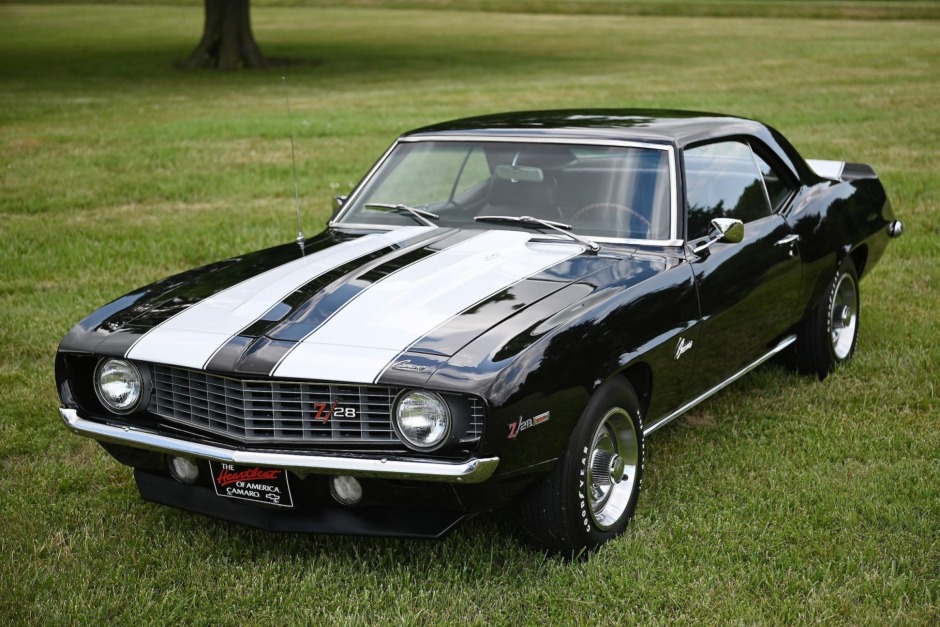

























Description
This 1969 Chevrolet Camaro Z/28 has been refinished in black with white stripes over a black vinyl interior, and its 302ci V8 is paired with a four-speed manual transmission and a 12-bolt rear axle. Other equipment includes a limited-slip differential, 15″ Rally wheels, front disc brakes, a tachometer, and an AM/FM radio. The car was built in April 1969 and delivered new to Briggs Chevrolet of South Amboy, New Jersey. The seller acquired the car out of…
This 1969 Chevrolet Camaro Z/28 has been refinished in black with white stripes over a black vinyl interior, and its 302ci V8 is paired with a four-speed manual transmission and a 12-bolt rear axle. Other equipment includes a limited-slip differential, 15″ Rally wheels, front disc brakes, a tachometer, and an AM/FM radio. The car was built in April 1969 and delivered new to Briggs Chevrolet of South Amboy, New Jersey. The seller acquired the car out of Washington in 2002 and has since moved it to Kansas. Service over the past seven years has included replacing steering components, the front and rear springs, door locks, window cranks, the exhaust, ignition components, heater hoses, and the fuel pump. Other items were replaced to address incorrect components noted by Jerry MacNeish of Camaro Hi-Performance Inc following an inspection in 2018.
The car was delivered new in Burnished Brown (61-61) and has been refinished in black with white stripes that extend over the cowl-induction hood as well as the trunk lid and rear spoiler.
Gray-finished 15″ Rally wheels wear beauty rings as well as Chevrolet Motor Division hubcaps and are mounted with Goodyear Wide Tread GT white-letter tires. The car received power-assisted front disc brakes and rear drums from the factory. The seller states that the front end was rebuilt with a replacement idler arm, tie rods, ball joints, and other parts in 2015 to correct loose steering. The springs have been replaced front and rear, and the brake booster, master cylinder, and lines also have been replaced.
The black interior (711) features front bucket seats and a rear bench with vinyl upholstery. Black carpeting covers the floor, and the car was optioned with a center console and an AM/FM radio. The car is also equipped with a Hurst shifter as well as two aftermarket speakers mounted on the package shelf. The seller notes that the dashboard trim is lifting in one corner, and the window cranks and the door locks have been replaced.
A three-spoke woodgrain steering wheel sits ahead of instrumentation that includes a 120-mph speedometer and a tachometer with a 6k-rpm redline. Four auxiliary gauges are located ahead of the shifter. The ammerter does not work, the clock operates intermittently, and the seller notes of a crack in the Rosewood steering wheel. The five-digit odometer shows 1k miles, approximately 500 of which have been added by the seller over the past two decades. True mileage is unknown.
A matching 15″ spare with a BFGoodrich Radial T/A tire is located in the trunk, which also houses a fire extinguisher. The houndstooth liners were sourced by the seller.
The car received a 302ci V8 that was advertised at 290 horsepower and 290 lb-ft of torque when new. Under the seller’s ownership the Holley carburetor has been rebuilt, and the oil was changed in preparation for the sale. The following components are said to have been replaced or installed under the seller’s ownership:
- Gardner Deep Tones exhaust system
- Alternator (1100837/9C7)
- Fan clutch (CZ69)
- Delco ignition coil (270)
- Spark-plug wires
- Thermostat housing (3877660)
- Heater hoses
- Fuel pump
- Cowl-injection components
- PCV valve, hose, and clamps
- Delco horns
- Battery topper
- Various decals, belts, and hardware
Power is delivered to the wheels through a four-speed Muncie M20 manual transmission and a 12-bolt rear axle with a 3.73:1 final-drive ratio and a limited-slip differential. The MacNeish report indicates that these components are original to the car.
The four-page report from Jerry MacNeish of Camaro Hi-Performance Inc was compiled in 2018. Page two indicates a number of component issues, and the seller states that only the underlined items have not been subsequently addressed. Page four shows that the engine pad bears a stamping ending in DZ, which is correct for a 302ci V8 with a manual transmission for 1969. However, the MacNeish report notes that the characters in the stamping are different from other period stampings; more information is available in the report.
- 1k Miles Shown, TMU
- 302ci V8
- Holley 4053 Carburetor
- 4-Speed Manual Transmission
- 12-Bolt Rear Axle w/Limited Slip
- Refinished in Black w/White Stripes
- X77 Trim Package
- Front and Rear Spoilers
- Black Vinyl Interior
- AM/FM Radio and Clock
- 15″ Rally Wheels
- Power Brakes w/Front Discs
- Gardner Deep Tones Exhaust System
- Jerry MacNeish Report
- NCRS Shipping Data Report








